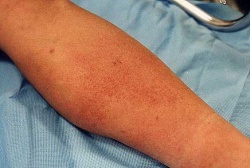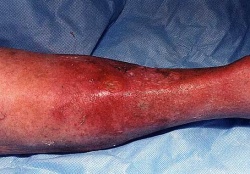Cellulitis
Original Editors - Students from Bellarmine University's Pathophysiology of Complex Patient Problems project.
Top Contributors - Kacie McClendon, Elaine Lonnemann, Erica Shelley, Kim Jackson, Lucinda hampton, Fasuba Ayobami, 127.0.0.1, WikiSysop, Karen Wilson, Vidya Acharya, Claire Knott and Evan Thomas
Definition/Description[edit | edit source]
Cellulitis is a localized bacterial skin infection, which typically affects the lower limbs but can occur on any area of skin and underlying subcutaneous tissue It is characterized by acute onset of redness, inflammation, pain, and swelling of the affected area. Accompanying symptoms include generalized fever, rigors, nausea, and vomiting.[1]
The infection is most commonly caused by B-Hemolytic Streptococci bacteria and reoccurs up to 50% of the time in the lower extremity.[2] Most individuals diagnosed with cellulitis have a low risk of severe complications but few suffers can have severe sepsis, local gangrene, and/or necrotising fasciitis.[1]
A mild case of cellulitis[3]
A severe case of cellulitis that developed under a cast[3]
Prevalence[edit | edit source]
- 650,000 hospital admissions per year in the United States are due to cellulitis.[4]
- When hospitalized, patients with recurrent cellulitis require longer hospitalizations relative to nonrelapsing cellulitis patients.[5]
- From 1998-2006, 10% of all infectious-disease hospitalizations were related to cellulitis[5]
- 22-49% of patients who have cellulitis report at least one previous episode[5]
- Recurrences, typically in the same location, occur approximately 14% of cellulitis cases within 1 year and in 45% of cases within 3 years[5]
Characteristics/Clinical Presentation[edit | edit source]
Typical symptoms include acute poorly demarcated and spreading erythema along with pain, swelling, and warmth of the lower extremity but can occur on any area of skin or underlying subcutaneous tissue.[2][5] Additional symptoms may include fever, nausea, vomiting, and rigors[5].[6]Other features include proximal dilated and edematous skin lymphatics and bulla formation. Cellulitis predominantly has a unilateral presentation, most commonly in the lower extremity.[5]
Classic presentation of cellulitis: poorly demarcated erythema[7]
Associated Co-morbidities[edit | edit source]
Diabetes Mellitus is one of most common comorbidities among those hospitalized for acute bacterial infections including cellulitis.
Following a cellulitis infection, those with diabetes require a longer course of antibiotic therapy and are more likely to have an outpatient follow up visit.[8]
Lymphatic flow changes can predispose individuals to a cutaneous infection. Examples of co-morbidities that result in lymphatic flow changes include peripheral vascular disease, liposuction, radiation therapy, lymph node dissection,' and lymphedema
Medications[edit | edit source]
Cephalexin, Dicloxacillin, Penicillin VK, Amoxicillin, and Clindamycin are typical Antistreptococcal Antimicrobial agents for the treatment of typical cellulits that is considered mild and does not show signs of systemic involvement. [5]
Table 1 indicates which medications would be appropriate based on the severity of symptoms and the risk of Methicillin-resistant Staphylococcus aureus (MRSA).
| Clinical Presentation | Appropriate Antibiotic Treatment |
|---|---|
| Routine Cellulitis with low suspicion of MRSA | Dicloxacillin, Cephalexin, Nafcillin, or Cefazolin |
| High suspicion of MRSA or Penicillin allergy | Doxycyline, Clindamyciin, Trimethoprim-sulfamethoxazole |
| High suspicion of MRSA with signs and symptoms of severe infection or patient did not respond to intitial routine treatment | Vancomycin♦, Linezolid |
Diagnostic Tests/Lab Tests/Lab Values[edit | edit source]
Cultures are typically not beneficial in making a cellulitis diagnosis. It is most commonly diagnosed by history and physical examination alone. Certain laboratory tests can indicate the presence of infection, but are not specific to cellulitis alone. Elevated white blood cell count, C-reactive protein, and erythrocyte sedimentation rate are the most common laboratory results in people with cellulitis, though the prevalence of these results varies widely on a case by case basis
Imaging studies can identify more severe infections to differentiate from cellulitis, but are not a reliable diagnostic tool for cellulitis itself.
Etiology/Causes[edit | edit source]
add text here
Systemic Involvement[edit | edit source]
add text here
Medical Management (current best evidence)[edit | edit source]
add text here
Physical Therapy Management (current best evidence)[edit | edit source]
add text here
Differential Diagnosis[edit | edit source]
add text here
Case Reports/ Case Studies[edit | edit source]
add links to case studies here (case studies should be added on new pages using the case study template)
Resources
[edit | edit source]
add appropriate resources here
Recent Related Research (from Pubmed)[edit | edit source]
see tutorial on Adding PubMed Feed
Extension:RSS -- Error: Not a valid URL: addfeedhere|charset=UTF-8|short|max=10
References[edit | edit source]
see adding references tutorial.
- ↑ 1.0 1.1 Cite error: Invalid
<ref>tag; no text was provided for refs namedMason - ↑ 2.0 2.1 Cite error: Invalid
<ref>tag; no text was provided for refs namedTsai - ↑ 3.0 3.1 Medscape. Cellulitis. http://emedicine.medscape.com/article/214222-overview (accessed 27 Feb 2017).
- ↑ Raff AB, Kroshinsky D. Cellulitis: A Review. JAMA. 2016;316(3):325-37. http://jamanetwork.com/pdfaccess.ashx?url=/data/journals/jama/935437/ (accessed 27 Feb 2017).
- ↑ 5.0 5.1 5.2 5.3 5.4 5.5 5.6 5.7 Cite error: Invalid
<ref>tag; no text was provided for refs namedRaff - ↑ Kilburn SA, Featherstone P, Higgins B, Brindle R. Interventions for cellulitis and erysipelas. (Cochrane review). Cochrane Database Syst Rev. 2010(6):CD004299.
- ↑ Bailey E, Kroshinsky D. Cellulitis: Diagnosis and Management. Dermatologic Therapy. 2011;24:229–39.http://onlinelibrary.wiley.com/doi/10.1111/j.1529-8019.2011.01398.x/full (accessed 15 Mar 2017).
- ↑ Jenkins TC. Comparison of the Microbiology and Antibiotic Treatment among Diabetic and Non-Diabetic Patients Hospitalized for Cellulitis or Cutaneous Abscess. J Hosp Med. 9ADADDec12;:788–94.https://www.ncbi.nlm.nih.gov/pmc/articles/PMC4256165/ (accessed 28 Feb 2017).








